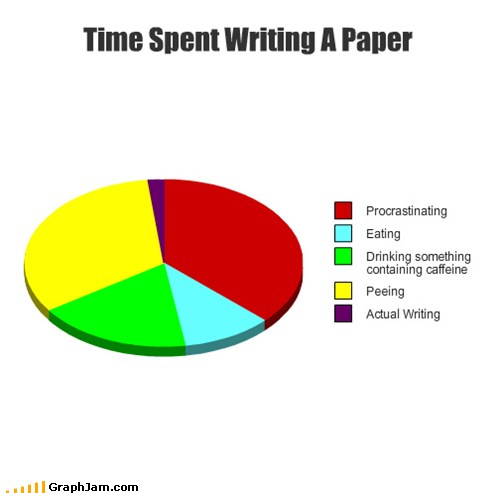![]() Say what you mean: Put the most important meaning words in the most important grammatical positions. This move is one of your most important revision strategies. It will help you get rid of wordiness, initial delaying constructions, and clunky clauses; and it will encourage you to subordinate properly.*
Say what you mean: Put the most important meaning words in the most important grammatical positions. This move is one of your most important revision strategies. It will help you get rid of wordiness, initial delaying constructions, and clunky clauses; and it will encourage you to subordinate properly.*
What do you think? If you were making the chart, what would it look like?
ALTERNATIVE CHARTS WELCOME
Paper length: 8 pages, double spaced, typed.
DUE DATE for draft: Tuesday, 3/5
DUE DATE for revised paper: Thursday, 3/14
The draft is required. If you want to hook up with a peer reader, please bring TWO copIes, one for me (AJVS) and one for a peer reader.
The draft will not receive a separate grade, but turning in a draft is necessary for completing the paper requirement. Papers without drafts will have grades reduced significantly.
You are also welcome to talk with me in office hours about your draft -- by yourself or along with your peer reader.
I recommend that you work with a peer reader. It's not required, but I'm providing peer-reading guidelines, and you will almost certainly benefit from "being read."
Peer reading: Click on link for peer-reading guidelines.
COMMENTARY: Along with the final draft of your paper, please write a 1-2 page commentary on the writing of your paper. How did things go? What sort of trouble spots did you run into? How did you handle them? What did you learn--from handling trouble spots? If you had a peer reader, what did you learn from reading and being read? Did anything about your thinking surprise you? The commentary is informal and will not be graded separately from the paper, but it is required. I read the commentary before reading the paper.
PAPER TOPICS:
NB: For all topics, please read and take seriously "Paragraph and Sentence Pointers," outlined on the Short Paper page.
NB: The questions that follow each paper topic will help you get started. They will not help you organize your paper (you can't, in other words just answer the questions and have a paper). You might want to think of further questions to add to the list.
The success of your paper will depend on close analysis.
1. Survival might be said to be central to both Robinson Crusoe and Pamela. Develop a thesis and write a paper in which you compare these works' uses or treatments of survival.
Thinking questions:
Why is survival important in each work?
What are the dangers that threaten survival?
What strategies enable survival?
Does anything trump survival?
How does the effort to survive shape the "self" of the characters?
2. Both Robinson Crusoe and Pamela are first-person accounts, but they are in many ways quite different. Compare the two fictions based on a close analysis of how the characters write their stories.
Thinking Questions:
Describe to yourself how each work begins.
Why does each figure tell a self-story?
What is the occasion for telling it?
What is the character's motivation for telling it?
What are the benefits of telling it?
Who are the implied readers?Be very careful to avoid being over general here. Close analysis of language will be essential to the success of your paper.
3. Hume says of the self--
"But setting aside some metaphysicians of this kind, I may venture to affirm of the rest of mankind, that they are nothing but a bundle or collection of different perceptions, which succeed each other with an inconceivable rapidity, and are in a perpetual flux and movement. Our eyes cannot turn in their sockets without varying our perceptions. Our thought is still more variable than our sight; and all our other senses and faculties contribute to this change; nor is there any single power of the soul, which remains unalterably the same, perhaps for one moment.
Consider carefully Hume's understanding of the self as "variable" rather than "fixed" and make an argument about the self as it appears in Robinson Crusoe and in Pamela.
What might the terms "variable" and "fixed" mean in these fictions? What difference does it make whether you read the "selves" they present as variable or fixed?
4. After discovering the footprint and being consumed by fear, Robinson Crusoe says,
I whose only Affliction was, that I seem'd banished from human Society, that I was alone, circumscrib'd by the boundless Ocean, cut off from Mankind, and condemn'd to what I call'd silent Life; that I was as one who Heaven thought not worthy to be number'd among the Living, or to appear among the rest of his Creatures; that to have seen one of my own Species, would have seem'd to me a Raising me from Death to Life, and the greatest Blessing that Heaven it self, next to the supreme Blessing of Salvation, could bestow; I say, that I should now tremble at the very appprehensions of seeing a Man, and was ready to sink into the Ground at but the Shadow or silent Appearance of a Man's having set his Foot in the Island (178).
Begin your paper with a close analysis of this section. Then consider whether Pamela has comparable episodes of fear that cause her to question her self. Do readings from Augustine, Descartes, or Hobbes or the lecture on Hume provide any insight into this issue?
5. The problem of equality: We know the problem that equality poses in Hobbes's Leviathan. Does Robinson Crusoe pose a problem of equality or inequality? What about Pamela? Analyze particular sections of the novels and draw on your understanding of Hobbes to arrive at a claim about the problem of equality in these works. Remember that the success of your paper depends on close analysis.
1. Read the paper until you find the thesis. Circle the key terms of the thesis, and put an asterisk next to it in the margin of the paper. Based on the thesis statement, how do you expect the essay to unfold? Can you imagine objections that the writer should take into account? Do you remember any material from our reading that might be helpful to the writer? (That is, can you offer the writer specific quotations that might be useful in the development of his or her paper?)
2. Read the paper through for a first impression. What strikes you about it? What are its best sections?3. Were you right about the thesis? If not, what now appears to be the thesis to you? Does the paper follow through on it? If the paper seems to have more than one thesis, do you see any relation between them?
4. Locate and underline transitions between paragraphs. Do the transitions follow the "plot"? Or do they follow the development of the writer's thinking?
5. Comment in detail on a paragraph that "works" and a paragraph that doesn't. What hooks sentences together in the paragraph that works? What kind of help does the non-working paragraph need?
6. What did you learn from the paper? What do you think the writer will learn from you?
7. You may want to type responses to these questions on a separate page. You may comment directly in the margins of the paper if you'd like. But you don't need to correct spelling, punctuation, etc.
PARAGRAPH AND SENTENCE POINTERS
Say what you mean: Put the most important meaning words in the most important grammatical positions. This move is one of your most important revision strategies. It will help you get rid of wordiness, initial delaying constructions, and clunky clauses; and it will encourage you to subordinate properly.*
Hook-ups: Sentences in a paragraph must "hook on to" preceding sentences. In each case, look for the stated or implied connector.
-------In hooking on to a previous sentence, each sentence does something to the previous one. You need to be able to say what each sentence is doing to the one before it. If your sentences have not met each other yet, they don't belong in the same paragraph.Develop your paragraphs: Most paragraphs in English start out in a certain direction and keep on going that way. Many start in one direction and then turn (with such words as "however" and "nevertheless"). There are two "rules" about turning: a) you can only turn once per paragraph; b) all sentences following the turn support that turn OR the original direction of the paragraph.*
Test your paragraphs with the "paragraph test": cut the paragraph into sentences and see if another intelligent, attentive person can put the paragraph together again.
*These two ideas are from Frederick Crews's The Random House Handbook.
Key to AJVS comments and questions
The turtle and the hare
from my garden.

